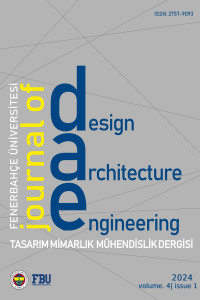Öz
Smart materials are new generation materials that have the ability to change the properties of an object. These innovative materials generally work on the principle of showing various reactions depending on a stimulus. It can be said that they offer an innovative solution and are open to development based on scientific studies, and their use in many areas will come to the fore in the future. This scope of work; In addition to the definition and classification of smart materials, the definition and classification of smart materials in architecture will be explained, and then innovative material solution suggestions in architectural applications will be discussed. After all this is explained; The application, usage, assembly and details of five different selected smart material applications, which are the most important part of this study, will be examined and explained
Anahtar Kelimeler
Kaynakça
- Addington, M. & Schodek, D. (2005). Smart Materials and New Technologies: For the Architecture and Design Professions. Architectural Press, Boston.
- Allobeidi, M. & Alsarraf A. (2018). “The Impact of the use of Smart Materials on the Façades of Contemporary Buildings”. International Journal of Engneering and Technology, Sayı: 7, s.744-750.
- Cloudhem. (2020). https://www.cloudchem.com.cn
- Dobrescu, L. A. (2021). From traditional to smart building materials in architecture. In IOP Conference Series: Materials Science and Engineering 2021; 1203(3), 032113.
- Karalı, C.H. (2019). Akıllı malzemelerin iç mimarlıkta kullanımı. Maltepe Üniversitesi Fen Bilimleri Enstitüsü Yüksek Lisans Tezi, İstanbul, Türkiye.
- Monk, P. M., & Mortimer, R. J. & Rosseinky, D. R. (2007). Electrochromism and electrochromic devices. Cambridge: Cambridge University Press.
- Nikolov, N., & Fox, J. (2014). Radiation-active surface design: The use photocatalytic concrete enabling buildings to be active environmental remediators. Eco-Architecture V: Harmonisation.
- Özgönül Şensan, Ö. (2019). Use of smart materials in the design of dynamic intelligent surfaces. The Graduate School of Social Sciences of Izmir University of Economics, Yüksek Lisans Tezi, İzmir, Türkiye, 2019.
- Ng, E. S. W. & Schweitzer, L., & Lyons, S. T. (2010). New generation, great expectations: A field study of the millennial generation. Journal of Business and Psychology, 25(2), 281–292. https://doi.org/10.1007/s10869-010-9159-4
- Ritter, A. (2007). Smart materials in architecture, interior architecture and design. Basel: Birkhäuser.
- Yüksel Ayvaz, Ö. (2019). Akıllı malzemelerin mimaride kullanım olanakları. Karadeniz Teknik Üniversitesi Fen Bilimleri Enstitüsü Yüksek Lisans tezi, Trabzon, Türkiye.
- (https://www.archdaily.com/920979/10-solutions-for-adaptive-walls-for-more resilient-architecture)
- https://iaac.net/project/translated-geometries/
- https://www.sageglass.com/smart-windows/product-overview
- https://www.saint-gobain-glass.com/products/priva-lite
- https://vibuma.com/en/blog/low-e-glass-easy-to-save-energy.thread1030.html
- https://www.arup.com/news-and-events/modularization-meets-variability-futurium-showcases-curtain-walling-of-tomorrow
- https://www.archdaily.com/49150/media-tic-enric-ruiz-geli
- https://www.glassonweb.com/article/futurium-berlin-ventilated-facade-system-with- structurally-bonded-textured-glass
- https://www.faulders-studio.com/GEOTUBE-TOWER
- https://www.arup.com/projects/solar-leaf
- http://www.prosolve370e.com/home
Öz
Akıllı malzemeler bir nesnenin özelliklerini değiştirme yeteneğine sahip olan yeni nesil malzemelerdir. Yenilikçi olan bu malzemeler genellikle bir uyarana bağlı olarak çeşitli tepkiler gösterme prensibine dayalı çalışmaktadırlar. Yenilikçi bir çözüm önerisi sunmaları ve üzerlerine yapılan bilimsel çalışmalara bağlı gelişime açık malzemeler oldukları ve gelecekte birçok alanda kullanımının öne çıkacağı söylenebilir. Bu çalışma kapsamında; akıllı malzemelerin tanımı, sınıflandırılmasının yanı sıra mimarlıkta akıllı malzemenin tanımı ve sınıflandırılması konuları açıklanacak, akabinde mimarlık uygulamalarında yapılan yenilikçi malzeme çözüm önerilerine değinilecektir. Tüm bunlar anlatıldıktan sonra; bu çalışmada asıl önem teşkil eden kısım olan, seçilmiş beş farklı akıllı malzeme uygulamasının uygulama, kullanım, montaj ve detayları incelenecek ve açıklanacaktır.
Anahtar Kelimeler
Kaynakça
- Addington, M. & Schodek, D. (2005). Smart Materials and New Technologies: For the Architecture and Design Professions. Architectural Press, Boston.
- Allobeidi, M. & Alsarraf A. (2018). “The Impact of the use of Smart Materials on the Façades of Contemporary Buildings”. International Journal of Engneering and Technology, Sayı: 7, s.744-750.
- Cloudhem. (2020). https://www.cloudchem.com.cn
- Dobrescu, L. A. (2021). From traditional to smart building materials in architecture. In IOP Conference Series: Materials Science and Engineering 2021; 1203(3), 032113.
- Karalı, C.H. (2019). Akıllı malzemelerin iç mimarlıkta kullanımı. Maltepe Üniversitesi Fen Bilimleri Enstitüsü Yüksek Lisans Tezi, İstanbul, Türkiye.
- Monk, P. M., & Mortimer, R. J. & Rosseinky, D. R. (2007). Electrochromism and electrochromic devices. Cambridge: Cambridge University Press.
- Nikolov, N., & Fox, J. (2014). Radiation-active surface design: The use photocatalytic concrete enabling buildings to be active environmental remediators. Eco-Architecture V: Harmonisation.
- Özgönül Şensan, Ö. (2019). Use of smart materials in the design of dynamic intelligent surfaces. The Graduate School of Social Sciences of Izmir University of Economics, Yüksek Lisans Tezi, İzmir, Türkiye, 2019.
- Ng, E. S. W. & Schweitzer, L., & Lyons, S. T. (2010). New generation, great expectations: A field study of the millennial generation. Journal of Business and Psychology, 25(2), 281–292. https://doi.org/10.1007/s10869-010-9159-4
- Ritter, A. (2007). Smart materials in architecture, interior architecture and design. Basel: Birkhäuser.
- Yüksel Ayvaz, Ö. (2019). Akıllı malzemelerin mimaride kullanım olanakları. Karadeniz Teknik Üniversitesi Fen Bilimleri Enstitüsü Yüksek Lisans tezi, Trabzon, Türkiye.
- (https://www.archdaily.com/920979/10-solutions-for-adaptive-walls-for-more resilient-architecture)
- https://iaac.net/project/translated-geometries/
- https://www.sageglass.com/smart-windows/product-overview
- https://www.saint-gobain-glass.com/products/priva-lite
- https://vibuma.com/en/blog/low-e-glass-easy-to-save-energy.thread1030.html
- https://www.arup.com/news-and-events/modularization-meets-variability-futurium-showcases-curtain-walling-of-tomorrow
- https://www.archdaily.com/49150/media-tic-enric-ruiz-geli
- https://www.glassonweb.com/article/futurium-berlin-ventilated-facade-system-with- structurally-bonded-textured-glass
- https://www.faulders-studio.com/GEOTUBE-TOWER
- https://www.arup.com/projects/solar-leaf
- http://www.prosolve370e.com/home
Ayrıntılar
| Birincil Dil | Türkçe |
|---|---|
| Konular | Mimarlık (Diğer), Yapı Teknolojisi |
| Bölüm | Araştırma Makaleleri |
| Yazarlar | |
| Yayımlanma Tarihi | 16 Temmuz 2024 |
| Gönderilme Tarihi | 17 Şubat 2024 |
| Kabul Tarihi | 27 Haziran 2024 |
| Yayımlandığı Sayı | Yıl 2024 Cilt: 4 Sayı: 1 |


